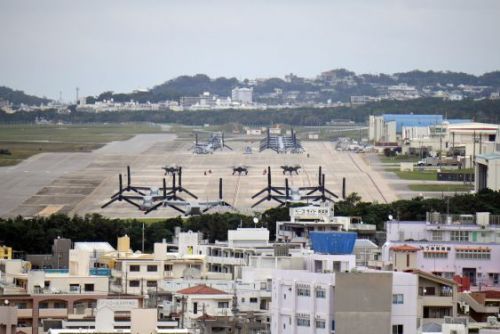Complaints of aircraft noise from Air Station Futenma at a record high of 684

Air Station Futenma, located in the middle of a city area, taken in December 2018 in Ginowan City.
April 12, 2019 Ryukyu Shimpo
In 2018, Ginowan City, Okinawa Prefecture received 684 complaints pertaining to the aircraft noise from the U.S. Marine Corps Air Station Futenma.
This is a record high since Ginowan City began accepting complaints in 2002.
The number of complaints from 2018 is 50 percent higher than that of 2017, and there are even records showing aircrafts noises at over 120 decibels.
For five years in a row, the number of complaints has continued to grow.
The number of complaints from 2018 surpasses the 549 complaints from 2011 when there was a flood of complaints about radio disturbances when people were switching to terrestrial digital broadcasting.
April 12 marked 23 years since Japan and the U.S. agreed to return the Air Station Futenma land back to Japan.
The current situation has made it clear once again that local residents are reaching their mental and physical limits due to the burden of hosting a military base.
It seems that the main cause lies in increased number of flights by transient aircrafts, such as the state of the art short take-off and vertical landing (STOVL) stealth fighter F-35B, for training purposes.
There are many complaints about night flights.
It became distinctly apparent that noise regulatory measures to restrict training during the early mornings and nighttime were reduced to a formality.
Local residents continue to complain that the helicopters circling are extremely loud and that they are mentally drained because the aircrafts are flying at night.
The city continues to accept complaints about damages incurred by the base 24 hours a day.
According to a visual study by the Okinawa Defense Bureau, the number of takeoffs and landings by transient aircrafts between April 2018 and February 2019 were 1,455.
That is 1,040 more times than numbers from 2017 when the study started. According to the city’s data, the number of aircraft noise occurrences for 2017 was 12,152.
The loudest aircraft noise from 2018 was recorded in Ojanaku at 123.7 decibels during the day and 100.1 decibels at night.
120 decibels corresponds to being close to an airplane engine, while 100 decibels corresponds to being up close to an ambulance siren.
On April 12, 1996, the Japanese and American governments agreed to return the Air Station Futenma land back to Japan “within 5 to 7 years.”
But the opposition against relocating the base within Okinawa is deeply rooted.
Even after 23 years, the said air station continues to be used and there have been a series of accidents by aircrafts that belong to the same base.
In the name of being the “only solution,” the government continues to move forward with the Henoko base construction.
But Okinawa is requesting that the base be relocated to outside of Okinawa or Japan since merely relocating the base will not lead to an early return of Air Station Futenma.
(English translation by T&CT and Chelsea Ashimine)
Previous Article:Okinawa Governor protests fatal incident involving U.S. solider, resulting in local apprehension
Next Article:The three participating parties at a summit to reduce the base burden agree to set new deadline for closing MCAS Futenma
[Similar Articles]
- Futenma base will close, but military flights and local complaints persist
- “It was so loud that I couldn’t sleep”, Osprey land on MCAS Futenma just before 11:00 p.m.
- U.S. military nighttime takeoffs/landings violate noise-prevention agreement, citizens complain
- Osprey made up to 101 decibels of noise late at night in Ginowan City, citizens complained
- MV22-Osprey repeatedly flies out of Futenma Airfield after 11p.m., causing noise pollution
 Webcam(Kokusai Street)
Webcam(Kokusai Street)


